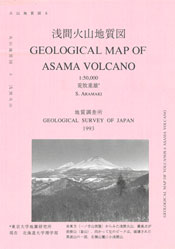Asama Volcano
1: Introduction / Geology and petrography of Asama Volcano and environs
2: Quaternary volcanic rocks
3: Pumice flow deposits / Pumice fall accompanied with pumice flow / Pumice and volcanic ash deposits of eastern foot area / Maekake crater
4: Activity of 1108 and Oiwake Pyroclastic Flow / Course of activity
5: Kamayama, the central cone, and recent activities
6: References
![]() PREV
PREV ![]() NEXT
NEXT
1: Introduction / Geology and petrography of Asama Volcano and environs
Introduction
Mount Asama is an active volcano situated at the boundary between Nagano and Gumma Prefectures. It is one of the representative volcanoes of Japan sited at the junction of Nasu Volcanic Zone, which extends from SW Hokkaido to Mount Haruna along the backbone of Honshu, and Fuji Volcanic Zone, which spreads from Izu Islands to Mount Fuji and Mount Yatsugatake in the south of Honshu. The total volume of the volcano amounts to about 56 km3 and is composed of stratovolcano, shield volcano, and lava dome of pyroxene andesite. The complexity of this nature is typical of Quaternary volcanoes of Japan. It also is well-known worldwide as one of the most active volcanoes in the world and eruption commonly repeats in a few years to several tens of years.
Geology and petrography of Asama Volcano and environs
Asama Volcano sits at the eastern margin of Fossa Magna where volcanic activities were rampant in Neogene. Thick Miocene to Neogene rocks of volcanic origin are projected to lie beneath Asama Volcano.
At the beginning of Miocene thick volcanogenic materials along with clastic sediments deposited in this area with transgression. During Pliocene the area gradually rose above the sea level and terrestrial sediments including lacustrine sedimentation became predominant. At the same time volcanic activities became furious with the center at the west of present-day Eboshi Volcano extending to Myogi and Kirizumi areas through eastern mountains of Saku Basin. In Quaternary many volcanoes such as Eboshi, Asama, Takatsuyama, Hanamagari, Kusatsu-Shirane, Azumaya, Shiga, and others were born in this area.
Kirizumi Group (Kz)
Thick formation of volcaniclastic rocks and lavas underlying in an area of Usui and Kirizumi Rivers is named Kirizumi Group. It is mostly consisting of tuff, tuff breccia, and lava flow. Andesitic rocks are predominant but some are dacitic. Those exposed at north of Karuizawa, north of Naka-Karuizawa, and upper reach of Yukawa River valley seem to be the uppermost part of Kirizumi Group and likely to be terrestrial deposits.
Shiga Group (Sg) and Myogi Volcano (My)
Rocks belonging to Shiga Group are distributed in an area of low hills of east and south of Minami-Karuizawa. They are similar in appearance to that of Kirizumi Group and are understood to be similar in age. Eruptive center of Myogi Volcano lies about 25 km away to the southeast of Asama Volcano and the west end of the distribution is exposed at Yagasakiyama etc. Most rocks are pyroxene andesitic tuff breccia and lava flows and show reverse magnetization.
Andesite of Moriizumiyama and Hiraofuji (Mh) and Shiga Welded Tuff (Sw)
Southern limit of ejecta from Asama Volcano lies in the west of Minami-Karuizawa to Iwamurada ( Asama township, now Saku City ) limited by hills consisting of Shiga Welded Tuff ( hornblende−pyroxene dacite ) and volcanic breccia and tuff breccia of identical lithology. Thickness of Shiga Welded Tuff is close to 200 m and welded part is being quarried. Moriizumiyama and Hiraofuji consist of pyroxene andesitic volcaniclastic rocks and lavas.
Komoro Group (Kg)
Pliocene strata of conglomerate, sandstone, mudstone, tuff breccia, tuff, and interbedded strata of those are exposed at Chikumagawa River cliffs around City of Komoro, Kuriyagawa River gorge, and Higashizawa River area, intercalated with several units of welded tuffs.
Kadokai Group (Kd)
Interbedded strata of sandstone and conglomerate distributed in Kadokai and Omae in the north foot area of Asama Volcano are named Kadokai Group.
Ojo Tuff Breccia (Oj) and other volcanic rocks (Vr)
These are rocks developed in Agatsuma River gorge between Haneo and Naganohara, and lower reaches of Kumagawa River. They are andesitic tuff breccia with thickness up to 500 m. Weak hydrothermal alteration is developed.
![]() PREV
PREV ![]() NEXT
NEXT
